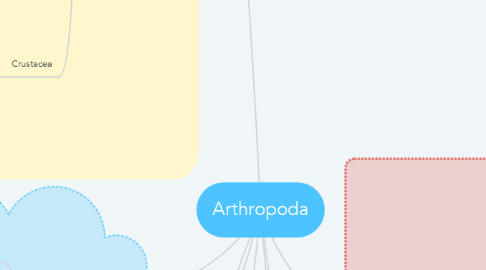
1. 5 Classes
1.1. Chilopoda
1.1.1. Centipedes
1.1.2. Flattened long bodies
1.1.3. 1 pair of legs per segment
1.1.4. Poison Fangs/Claws
1.1.5. Simple eyes
1.1.6. 1 pair of antennae
1.1.7. Some Carnivore + some herbivore
1.2. Diplopoda
1.2.1. Millipedes
1.2.2. Long rounded bodies
1.2.3. 2 pair of legs per segment
1.2.4. 1 pair of antennae
1.2.5. For defense roll into a ball/spiral + smell bad
1.3. Arachnida
1.3.1. Spiders and scorpions and ticks
1.3.2. 2 tagnata
1.3.2.1. Cephalothorax + abdomen
1.3.3. 4 pairs of legs
1.3.4. Webs
1.3.5. Chelicerae for biting/tearing
1.3.6. No antennae
1.3.7. Pedipalps - Multipurpose tools
1.3.8. Simple to complex eyes, various #'s
1.3.9. Scorpions have stingers
1.4. Hexapoda (Insects)
1.4.1. 3 pairs of legs
1.4.2. 3 tagmata
1.4.2.1. Head
1.4.2.2. Thorax
1.4.2.3. Abdomen
1.4.2.4. Bees, butterflies, wasps, beetles etc.
1.4.3. 1 pair of antennae
1.4.4. 2 pair of wings
1.4.5. Communication
1.4.5.1. Pheromones
1.4.5.2. Dances
1.4.6. Complete Metamorphosis
1.5. Crustacea
1.5.1. 2 pair of antennae
1.5.2. 2 tagmata
1.5.2.1. Cephalothorax
1.5.2.2. Abdomen
1.5.3. Crabs, lobster, krill, crayfish, shrimp, isopods, and barnacles
1.5.4. Swimmerets for swimming
1.5.5. Eyes are on stocks

